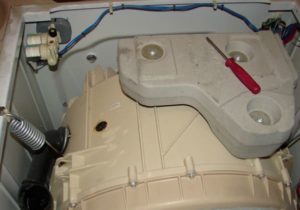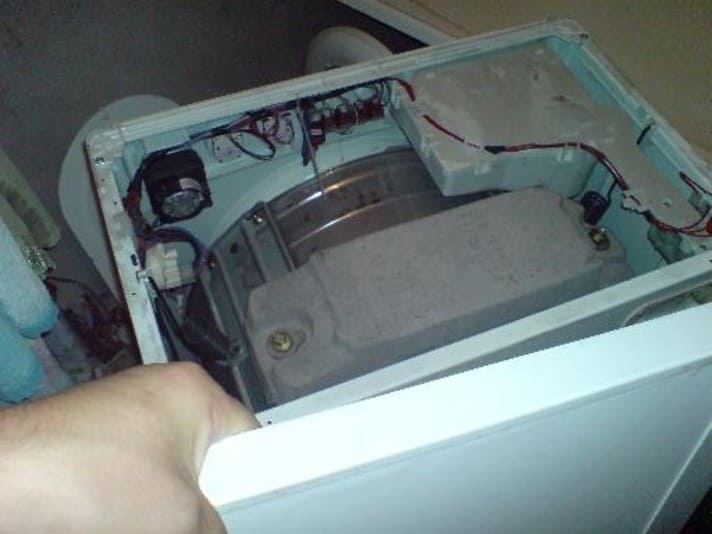 To prevent the washing machine from jumping around the bathroom during operation, it is equipped with counterweights - large metal or concrete blocks that prevent vibration and hold the household appliance in one place. They look durable, but over time, like other parts, they wear out, become loose, and require repair or replacement. Removing the counterweight in a washing machine yourself is not difficult, but read the article on how to do it.
To prevent the washing machine from jumping around the bathroom during operation, it is equipped with counterweights - large metal or concrete blocks that prevent vibration and hold the household appliance in one place. They look durable, but over time, like other parts, they wear out, become loose, and require repair or replacement. Removing the counterweight in a washing machine yourself is not difficult, but read the article on how to do it.
Why do you need to replace the counterweight?
Counterweight – position equalization block washing machine in space. It can be mounted with bolts or springs. In a machine that has been in use for a long time, the fastening parts gradually weaken and the counterweight begins to hit the tank. This situation is extremely unfavorable: as the device continues to be used, the loose concrete counterweight may crack or collapse due to vibration.
Problems that arise during the operation of the balancer are determined by the material from which it is made:
- Plastic blocks are the weakest and most unstable. They are quickly destroyed;
- Concrete is susceptible to cracking. Quite large pieces can fall off from them;
- Metal ones are stable, but the problem arises with fastenings. They become loose, dangle, and collide with the walls of the washing mashine.
If during washing the washing machine begins to shake and knock, then you need to carefully inspect its interior, including the fastenings. The loose ones need to be tightened. The broken fastener is replaced.
If tightening loose bolts does not help solve the vibration problem, then you need to pay attention to spring washers. These parts gradually become loose and compressed, which negatively affects the position of the counterweights. The bushings should be replaced and the bolts should be tightened thoroughly.
If the balancer is already cracked or split, then it is urgently replaced. Leaving a split block is unsafe: it cannot sufficiently absorb vibrations from the rotating drum. As a result, the destruction of the machine continues. There is nothing complicated in replacing the counterweight: you just need to carefully unscrew the bolts connecting it to the tank. In some cases, both the base and the fasteners need to be replaced.

How to find and remove the counterweight in a washing machine?
To get rid of the problem of vibration and noise when washing, you must first find a counterweight in the washing machine. This is not difficult: a large concrete block immediately catches the eye. Its condition is determined by eye: it should not have cracks or chips. Next, the structure should be tugged. If the fixing parts are not loose, the counterweight should not yield to physical pressure.It is recommended that owners do such simple diagnostics themselves once every six months; this will prevent vibration and serious breakdowns that require expensive repairs.
Counterweights are attached to the front wall of the tank, weighing it down. In the design, fastening elements are no less important than the weighting elements themselves. They ensure that the unit does not vibrate when washing at high speeds. To get to the counterweights, you will have to disassemble the washing machine.
A household appliance is disassembled to replace the balancer and eliminate vibration as follows:
- The top cover is removed. The dispenser tray is pulled out;
- The fasteners holding the control panel are unscrewed;
- Using a screwdriver, the plastic latches are released;
- The control panel is removed;
- The base is removed to gain access to the fastening parts of the front panel;
- All bolts are unscrewed and the front panel is removed;
- The counterweights are opened and checked for defects. Replaced if necessary.
Replacing the counterweight in washing machines of different brands
Replacing a cracked counterweight is not difficult. Even a person who does not have solid experience in repairing household appliances can cope with this. All you need is a set of wrenches and sufficient physical strength. It’s good if you have an electric impact wrench at home, which will greatly simplify the work.

IN Samsung washing machines balancing blocks are located in the upper and lower parts.To replace them, unscrew the bolts with a suitable wrench. The blocks in Beko machines are also easy to remove.
But with Ardo it may be a little more difficult. In older machines of this company, the front cover, through which you can easily get to the balancer, cannot be removed. You will have to almost completely empty the inside of the unit: remove the entire top panel, unhook the upper springs and lower shock absorbers to remove the tank.
Problems may also arise for Ariston owners. Equipment from the Italian manufacturer is considered high-quality, not designed for repair work. Therefore, in some washing machines (for example, in Hotpoint Ariston Aqualtis), both the upper and lower counterweights are attached to the tank in a non-standard way, held on cone-shaped springs that resemble dowels.
Owners of
Indesit machines also have to tinker with the replacement. The fasteners are non-standard: ordinary keys do not fit them. The way out of the situation is to make the key yourself. You need to take a pipe at least 20 cm long, 22 cm in diameter, make a 5 cm deep cut in the middle of one end.To replace them, the bolts are unscrewed with a suitable wrench. Blocks in Beko brand machines are also easily removed.But with Ardo it can be a little more difficult. On older washing mashines from this company, the front cover, through which you can easily get to the balancer, cannot be removed. You will have to almost completely empty the inside of the unit: remove the entire top panel, unhook the upper springs and lower shock absorbers to remove the tank.
Ariston owners may also have problems. Equipment from an Italian manufacturer is considered to be of high quality and is not designed for repair work. Therefore, in some washing machines (for example, in the Hotpoint Ariston Aqualtis), both the upper and lower counterweights are attached to the tank in a non-standard way, supported by cone-shaped springs resembling dowels.









